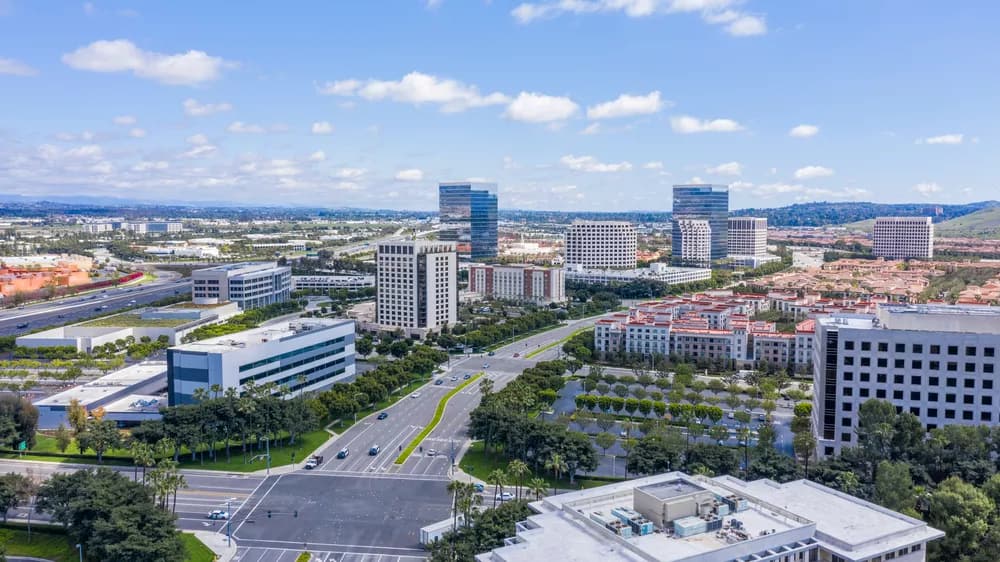






Please add profiles of those who were born, lived or died in Irvine, Orange County, California.
The Irvine Company started developing the area in the 1960s and it was fully incorporated in 1971.
Villages
Each of the villages was initially planned to have a distinct architectural theme.
El Camino Glen | College Park | The Colony | Columbus Grove | Cypress Village | Deerfield (mixed styles) | East Irvine | El Camino Real (Spanish/Neo-Eclectic) | Greentree | Irvine Groves | Irvine Spectrum (Contemporary/Moroccan) | Harvard Square | Heritage Fields | Laguna Altura | Lambert Ranch | Northpark (French Country, Formal French, Italian Country, Formal Italian, Monterey and Spanish Colonial) | Northpark Square (Spanish Mission) | Northwood (Bungalow, Craftsman) | Oak Creek (mixed styles) | Old Towne Irvine | Orangetree | Orchard Hills (Rural Craftsman/Spanish/Tuscan) | Park Lane | Parkcrest | Parkside | Pavilion Park | Portola Springs (Spanish/Tuscan) | Planning Area 40 (Future Village) | Quail Hill (Spanish/Tuscan) | Racquet Club | The Ranch | Rancho San Joaquin (Shed style) | Rosegate (Spanish/Tuscan) | Stonegate (Spanish) | Shady Canyon (Tuscan Ranch) | Turtle Ridge (Tuscan) | Turtle Rock (mixed styles) | University Hills | University Park (California Modern) | University Town Center (mixed styles) | Walnut (Prairie Style) | West Irvine (California Modern) | Westpark (Italian Riviera/Mediterranean) | The Willows | Windwood | Woodbridge (Atlantic Coast) | Woodbury Tuscan/Spanish/French) | Woodbury East (Spanish)
After Mexico's independence from Spain in 1821, the Mexican government secularized the missions and assumed control of the lands. It began distributing the land to Mexican citizens who applied for grants. Three large Spanish/Mexican grants made up the land that later became the Irvine Ranch: Rancho Santiago de Santa Ana, Rancho San Joaquin and Rancho Lomas de Santiago.
In 1864, Jose Andres Sepulveda, owner of Rancho San Joaquin, sold 50,000 acres to Benjamin and Thomas Flint, Llewellyn Bixby and James Irvine for $18,000 to resolve debts due to the Great Drought. In 1866, Irvine, Flint and Bixby acquired 47,000-acre Rancho Lomas de Santiago for $7,000. After the Mexican-American war the land of Rancho Santiago de Santa Ana fell prey to tangled titles. In 1868, the ranch was divided among three claimants as part of a lawsuit: Flint, Bixby and Irvine. The ranches were devoted to sheep grazing. However, in 1870, tenant farming was permitted.
In 1878, James Irvine acquired his partners' interests for $150,000. His 110,000 acres stretched 23 miles from the Pacific Ocean to the Santa Ana River. James Irvine died in 1886. The ranch was inherited by his son, James Irvine II, who incorporated it into the Irvine Company. James Irvine II shifted the ranch operations to field crops, olive and citrus crops.
In 1888, the Santa Fe Railroad extended its line to Fallbrook Junction, north of San Diego, and named a station along the way after James Irvine. The town that formed around this station was named Myford, after Irvine's son, because a post office in Calaveras County already bore the family name. The town was renamed Irvine in 1914.
By 1918, 60,000 acres of lima beans were grown on the Irvine Ranch. Two Marine Corps facilities, MCAS El Toro and MCAS Tustin, were built during World War II on ranch land sold to the government.
James Irvine II died in 1947 at the age of 80. His son, Myford, assumed the presidency of the Irvine Company. He began opening small sections of the Irvine Ranch to urban development.
The Irvine Ranch played host to the Boy Scouts of America's 1953 National Scout Jamboree. Jamboree Road, a major street which now stretches from Newport Beach to the city of Orange, was named in honor of this event. David Sills, then a young Boy Scout from Peoria, Illinois, was among the attendees at the 1953 Jamboree. Sills came back to Irvine as an adult and went on to serve four terms as the city's mayor.
Myford Irvine died in 1959. The same year, the University of California asked the Irvine Company for 1,000 acres for a new university campus. The Irvine Company sold the requested land for $1 and later the state purchased an additional 500 acres.
William Pereira, the university's consulting architect, and the Irvine Company planners drew up master plans for a city of 50,000 people surrounding the new university. The plan called for industrial, residential and recreational areas, commercial centers and greenbelts. The new community was to be named Irvine; the old agricultural town of Irvine, where the railroad station and post office were located, was renamed East Irvine. The first phases of the villages of Turtle Rock, University Park, Westpark (then called Culverdale), El Camino Real, and Walnut were completed by 1970.
On December 28, 1971, the residents of these communities voted to incorporate a substantially larger city than the one envisioned by the Pereira plan. By January 1999, Irvine had a population of 134,000 and a total area of 43 square miles.
After the Fall of Saigon in 1975, a large influx of Vietnamese refugees settled in nearby Fountain Valley, especially in the late 1970s and throughout the 80s, forming a large percentage of people in the city.
In late 2003, after a ten-year-long legal battle, Irvine annexed the former El Toro Marine Corps Air Station. This added 7.3 square miles of land to the city and blocked an initiative championed by Newport Beach residents to replace John Wayne Airport with a new airport at El Toro. Most of this land has become part of the Orange County Great Park.
Every October, Irvine hosts the Irvine Global Village Festival to celebrate the diversity among the citizens of Irvine and Orange County. The festival consists of exhibits from local merchants, entertainment from diverse cultures, and sampling of foods from various regions of the world. The event used to be held at Colonel Bill Barber Marine Corps Memorial Park but has since then been moved to the Orange County Great Park.
